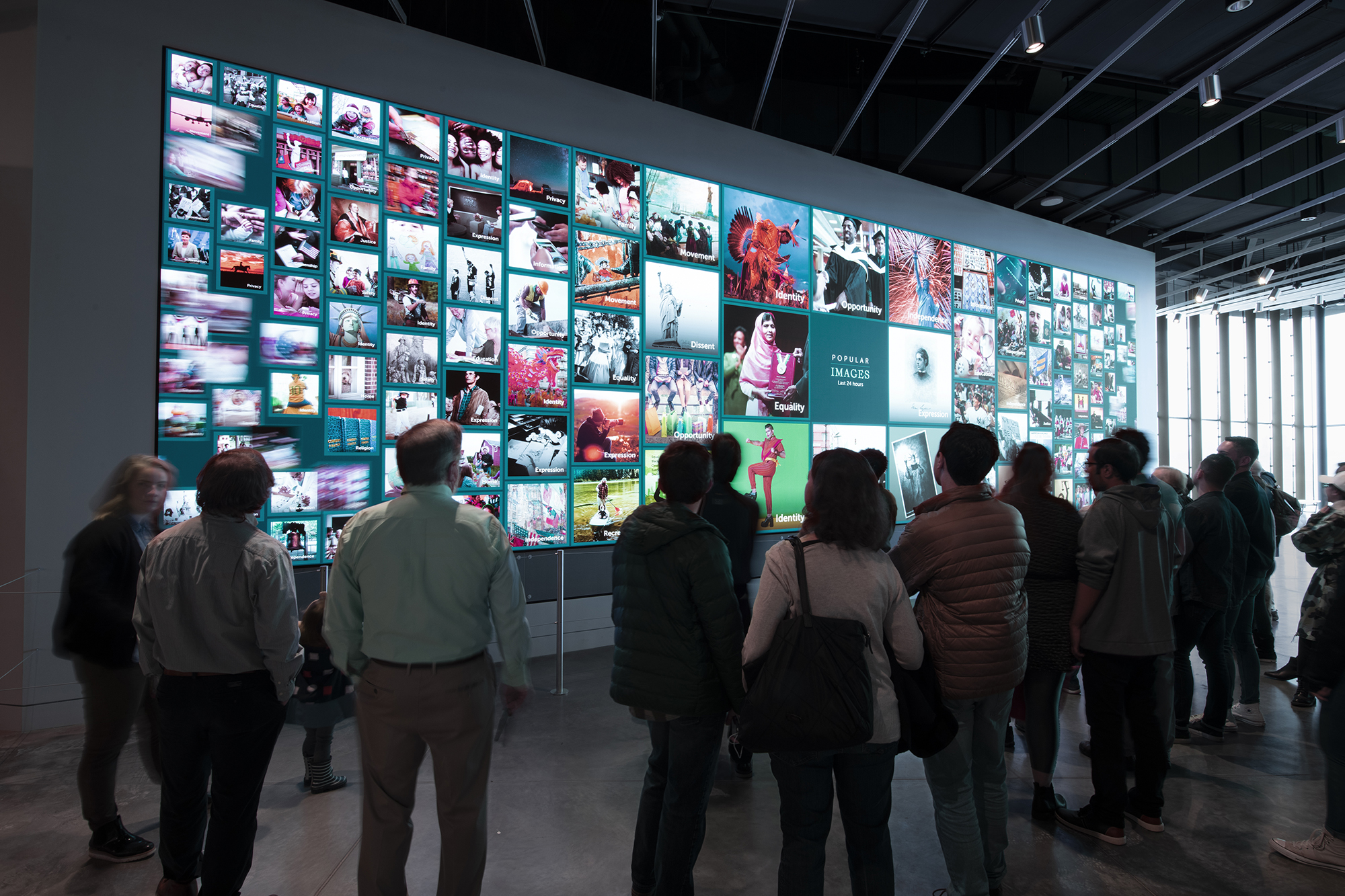The hospitality industry has been hit particularly hard during the pandemic, from food and accommodation services to arts and entertainment. While fully closed during the pandemic, many museums offered virtual tours to keep their exhibits available to audiences around the world. As the physical reopening of facilities continues, organizations like the American Alliance of Museums provide recommendations to help museums reopen to patrons safely and flexibly.
Museums find themselves in the position of having to balance the function of educating and entertaining visitors with very specific health and safety requirements mandated by federal, state, and local laws, as well as guidance from public health services, which puts them in a tough spot. For help, museum directors rely on integrators to help them create experiences that are both safe and engaging.
[The Digital Signage Best Practices Guide]
Emily Webster, leader of creative at NBBJ’s New York Experience Design Studio, ESI Design, suggests museums should not abandon their virtual efforts when they reopen. “Through technology, a museum with a regional footprint now has access to a global audience for their programs and mission,” she said. ESI Design is encouraging its clients to approach design expansions and renovations with a digital-first mindset and consider the virtual experience alongside the design of the museum environment.
Cameras and IR surfaces have long been used to create immersive and interactive environments. “These can be educational, interactive, and immersive, and always incredibly entertaining,” said Carol Feeley-Vario, PMP, LEED AP BD&C, project director at Diversified, no. 2 on the 2020 SCN Top 50 list. “By pairing this with timed tickets to avoid crowding, we can ensure museum interactives are safe.”
As museums begin to reopen, 10 museums in the United States, nine in Europe, and three in Asia are able to present Van Gogh: The Immersive Experience as a COVID-safe and family-friendly activity. (In a confusing bit of happenstance, there are no fewer than three traveling Van Gogh exhibitions in the United States this spring, with several of these exhibits competing in larger markets.) Van Gogh: The Immersive Experience is the one that’s “a 20,000-square-foot light and sound spectacular featuring two-story projections of the artist’s most compelling works.” It’s all-digital and hands-free, and health protocols are observed via timed entries with limited numbers of socially distanced museumgoers.
As more interactive exhibits are deployed, their scale and scope will continue to increase. “With that comes a comfort level to take on more ambitious projects and programming, like projection-mapping an entire environment to make it fully immersive,” said Scott Schoeneberger, managing partner at Bluewater. As an example of the scope, Schoeneberger cited a recent Bluewater project in which his team built out a fully immersive exhibit in a railcar.
Holistic Visitor Journey
The pandemic has highlighted the importance of the in-person shared and social experience, but it also made us appreciate the benefits of virtual experiences if in-person is impossible. Webster suggests taking advantage of what we’ve learned about virtual interactions over the past year by creating virtual tours and continuing to extend experiences far beyond the physical site and the IRL (in real life) experience.
“Museum experiences are about to transform into experiential platforms,” Webster said. “An experiential platform will allow institutions to reach visitors before they step through their doors and offer a nonlinear museum experience that is just as compelling whether you are there in person or dialing in from afar. An experiential platform will allow you to create an exhibit that is diverse in voice, diverse in the ways that people can access it, diverse in the senses it activates (sight, sound, touch, taste).”
The result would be an in-museum exhibit that can also be experienced in other places and other ways. “We will see more holistic storytelling that has online platforms operate hand in hand with the in-person experiences.”
Patrons will benefit from the broader perspective if exhibits are designed in ways that leave room for visitors to co-create their museum experience. “For the co-creation process, we want to create a place where visitors can contribute to the museum and share their perspective,” Webster said. “An example of this is at the emotional culmination of the Becoming Liberty exhibit at the Statue of Liberty Museum.”

Here, visitors are invited to join the conversation about liberty by sharing what liberty means to them. Visitors reflect on what they experienced in the museum through an interactive exhibit at one of 20 kiosks in which they share their portrait or selfie and select a set of images that express their perspectives on the meaning of liberty.
Webster explained, “Their choices join those made by other visitors in a sweeping, panoramic mosaic displayed at the entry to the gallery. After learning about liberty throughout the museum, visitors themselves are now part of liberty’s worldwide story and the digital mosaic that defines the global view of liberty.”
Interactive Experience
Not surprisingly, since the pandemic began, Bluewater has received inquiries about creating touchless interactive experiences and for information about various automated temperature scanning solutions. Interactivity will remain an essential aspect of the museum experience.
[ACMI Uses Audinate’s Dante to Create an Immersive Soundscape]
“We tend to see a lot of interactivity with our museum and exhibit requests,” Schoeneberger said. “This can be as straightforward as interactive content on a display or experiences that are a bit more unique.” In the Detroit ’67 exhibit at the Detroit Historical Society, for example, the team programmed an old rotary phone to ring at a central location after patrons visit the space. Answering the phone triggers a historic audio recording from an answering machine to begin playing.
“This was a simple yet creative approach to give that specific piece of content more impact,” he said. “We expect to see a continuation of interactive elements moving from digital canvases to the physical environment as things open back up.” Schoeneberger sees this as a response to a better understanding of available technology, decreasing costs, and increasing comfort by museum staff to take on digital programming tasks.
With increasing demand for control of an entire space, media servers become a critical part of the mix. “We’re always excited when that type of conversation takes place because it means we’re likely to go beyond just a series of displays or audio playback into a space where exploration and content delivery can happen more naturally and in a much more engaging manner,” Schoeneberger added.

The Timing Is Right
Future interactive museum experiences are likely to feature fewer high-touch surfaces. “They can be a huge draw to a museum, especially children’s museums,” said Diversified’s Feeley-Vario. “They are incredibly effective for communication, but they can be difficult to clean.”
There have always been design requirements for screen protection and cleaning, but not for pandemic-level cleaning. “In the past we have installed touch surfaces with an antimicrobial overlay,” she said. “Our original intention was protection against marking and scratching, but it had the added benefit of being able to be cleaned using traditional cleaning products.”
Immersive exhibit design can really shine now. “Typically, the entry to these is already timed. You follow through in a set series of stages, nothing is touched, and there are no small labels on the wall to read” that might create a crowd, explained Feeley-Vario. “The rooms and areas of an immersive exhibit can also be designed for a negative-pressure environment [a common infectious disease control in hospitals]. The air in these rooms has less pressure than the air outside the room so that, whenever the doors are opened, clean air from the hallway rushes into the negative-pressure area instead of potentially contaminated air flowing into the hall. The clean air comes in, and the potentially contaminated air gets filtered out an exhaust. With some minor tweaking, immersive designs can be safe and as impactful as ever.”
Challenging times in history have often resulted in innovation. “Innovation in exhibit design has been forced on us by COVID-19 in a truly global sense,” Feeley-Vario continued. “From small traveling exhibits to large institutions, we will all have to find a way to keep people safe.”
Exhibits may become more of a virtual experience or a healthy blend of physical installations with integrated technology to communicate information to the museumgoer. “I can see this being less of the typical audio tour and more of a dynamic museum app that one can use to identify items in the exhibits,” Feeley-Vario concluded.
Click here to read more stories from the June 2021 issue of SCN.

